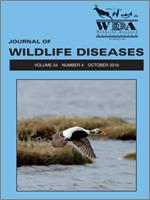In Argentina there is little information about diseases that affect exotic ungulates and the health risks that they pose to native wildlife, livestock, and humans. The aim of this study was to evaluate the health status of red deer (Cervus elaphus) in the Nahuel Huapi National Park and surrounding areas in Patagonia, Argentina. During three consecutive hunting seasons, necropsies were performed on 101 red deer, and tissues were examined histologically. The most common lesions were those associated with hepatic and pulmonary parasites. Fasciola hepatica was observed in 15 red deer and was associated with cholangiohepatitis (8%) and/or cholangitis (10%). Dictyocaulus sp. (likely Dictyocaulus eckerti) was associated with interstitial pneumonia (5%), bronchitis (5%), pulmonary emphysema (13%), and bronchus-associated lymphoid tissue hyperplasia (13%). Other findings included Sarcocystis spp. cysts in the myocardium (89%) associated with interstitial, focal, lymphoplasmacytic myocarditis (8%); periportal lymphoplasmacytic hepatitis (8%); hepatic centrilobular necrosis (6%); lymphoplasmacytic interstitial nephritis (25%); and follicular hyperplasia in mediastinal, prescapular, and prefemoral lymph nodes (86%). Our report of lesions caused by endemic parasites of livestock in free-ranging exotic red deer in Patagonia sets the foundation for a health-monitoring and -surveillance system of wildlife in this region, which is essential for the sustainable management of threatened Argentinean native fauna.
How to translate text using browser tools
1 October 2018
A SURVEY OF PARASITE LESIONS IN WILD RED DEER (CERVUS ELAPHUS) FROM ARGENTINA
Elizabeth Chang Reissig,
Adriana R. Massone,
Beatriz Iovanitti,
Eduardo J. Gimeno,
Francisco A. Uzal
ACCESS THE FULL ARTICLE

Journal of Wildlife Diseases
Vol. 54 • No. 4
October 2018
Vol. 54 • No. 4
October 2018
Argentina
exotic red deer
health
parasites
pathology




